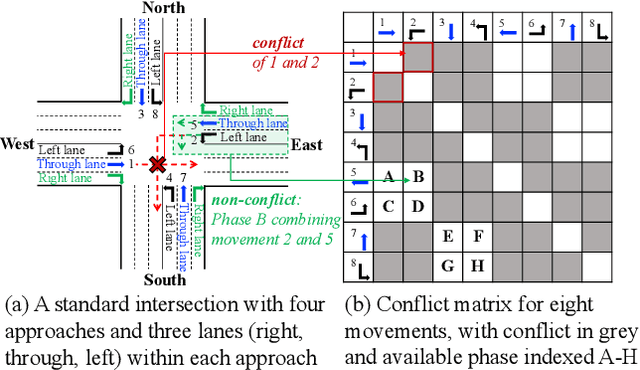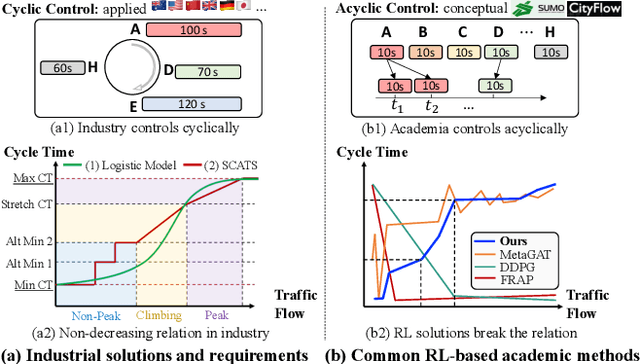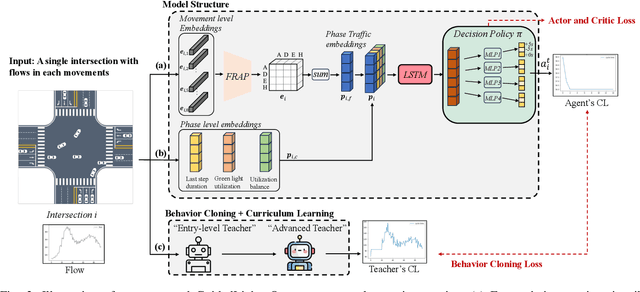Hangyu Mao
From Chaos to Order: The Atomic Reasoner Framework for Fine-grained Reasoning in Large Language Models
Mar 20, 2025Abstract:Recent advances in large language models (LLMs) have shown remarkable progress, yet their capacity for logical ``slow-thinking'' reasoning persists as a critical research frontier. Current inference scaling paradigms suffer from two fundamental constraints: fragmented thought flows compromising logical coherence, and intensively computational complexity that escalates with search space dimensions. To overcome these limitations, we present \textbf{Atomic Reasoner} (\textbf{AR}), a cognitive inference strategy that enables fine-grained reasoning through systematic atomic-level operations. AR decomposes the reasoning process into atomic cognitive units, employing a cognitive routing mechanism to dynamically construct reasoning representations and orchestrate inference pathways. This systematic methodology implements stepwise, structured cognition, which ensures logical coherence while significantly reducing cognitive load, effectively simulating the cognitive patterns observed in human deep thinking processes. Extensive experimental results demonstrate AR's superior reasoning capabilities without the computational burden of exhaustive solution searches, particularly excelling in linguistic logic puzzles. These findings substantiate AR's effectiveness in enhancing LLMs' capacity for robust, long-sequence logical reasoning and deliberation.
DMQR-RAG: Diverse Multi-Query Rewriting for RAG
Nov 20, 2024Abstract:Large language models often encounter challenges with static knowledge and hallucinations, which undermine their reliability. Retrieval-augmented generation (RAG) mitigates these issues by incorporating external information. However, user queries frequently contain noise and intent deviations, necessitating query rewriting to improve the relevance of retrieved documents. In this paper, we introduce DMQR-RAG, a Diverse Multi-Query Rewriting framework designed to improve the performance of both document retrieval and final responses in RAG. Specifically, we investigate how queries with varying information quantities can retrieve a diverse array of documents, presenting four rewriting strategies that operate at different levels of information to enhance the performance of baseline approaches. Additionally, we propose an adaptive strategy selection method that minimizes the number of rewrites while optimizing overall performance. Our methods have been rigorously validated through extensive experiments conducted in both academic and industry settings.
SkillTree: Explainable Skill-Based Deep Reinforcement Learning for Long-Horizon Control Tasks
Nov 19, 2024



Abstract:Deep reinforcement learning (DRL) has achieved remarkable success in various research domains. However, its reliance on neural networks results in a lack of transparency, which limits its practical applications. To achieve explainability, decision trees have emerged as a popular and promising alternative to neural networks. Nonetheless, due to their limited expressiveness, traditional decision trees struggle with high-dimensional long-horizon continuous control tasks. In this paper, we proposes SkillTree, a novel framework that reduces complex continuous action spaces into discrete skill spaces. Our hierarchical approach integrates a differentiable decision tree within the high-level policy to generate skill embeddings, which subsequently guide the low-level policy in executing skills. By making skill decisions explainable, we achieve skill-level explainability, enhancing the understanding of the decision-making process in complex tasks. Experimental results demonstrate that our method achieves performance comparable to skill-based neural networks in complex robotic arm control domains. Furthermore, SkillTree offers explanations at the skill level, thereby increasing the transparency of the decision-making process.
Mimicking Human Intuition: Cognitive Belief-Driven Q-Learning
Oct 02, 2024Abstract:Reinforcement learning encounters challenges in various environments related to robustness and explainability. Traditional Q-learning algorithms cannot effectively make decisions and utilize the historical learning experience. To overcome these limitations, we propose Cognitive Belief-Driven Q-Learning (CBDQ), which integrates subjective belief modeling into the Q-learning framework, enhancing decision-making accuracy by endowing agents with human-like learning and reasoning capabilities. Drawing inspiration from cognitive science, our method maintains a subjective belief distribution over the expectation of actions, leveraging a cluster-based subjective belief model that enables agents to reason about the potential probability associated with each decision. CBDQ effectively mitigates overestimated phenomena and optimizes decision-making policies by integrating historical experiences with current contextual information, mimicking the dynamics of human decision-making. We evaluate the proposed method on discrete control benchmark tasks in various complicate environments. The results demonstrate that CBDQ exhibits stronger adaptability, robustness, and human-like characteristics in handling these environments, outperforming other baselines. We hope this work will give researchers a fresh perspective on understanding and explaining Q-learning.
QPO: Query-dependent Prompt Optimization via Multi-Loop Offline Reinforcement Learning
Aug 20, 2024Abstract:Prompt engineering has demonstrated remarkable success in enhancing the performance of large language models (LLMs) across diverse tasks. However, most existing prompt optimization methods only focus on the task-level performance, overlooking the importance of query-preferred prompts, which leads to suboptimal performances. Additionally, these methods rely heavily on frequent interactions with LLMs to obtain feedback for guiding the optimization process, incurring substantial redundant interaction costs. In this paper, we introduce Query-dependent Prompt Optimization (QPO), which leverages multi-loop offline reinforcement learning to iteratively fine-tune a small pretrained language model to generate optimal prompts tailored to the input queries, thus significantly improving the prompting effect on the large target LLM. We derive insights from offline prompting demonstration data, which already exists in large quantities as a by-product of benchmarking diverse prompts on open-sourced tasks, thereby circumventing the expenses of online interactions. Furthermore, we continuously augment the offline dataset with the generated prompts in each loop, as the prompts from the fine-tuned model are supposed to outperform the source prompts in the original dataset. These iterative loops bootstrap the model towards generating optimal prompts. Experiments on various LLM scales and diverse NLP and math tasks demonstrate the efficacy and cost-efficiency of our method in both zero-shot and few-shot scenarios.
Beyond Local Views: Global State Inference with Diffusion Models for Cooperative Multi-Agent Reinforcement Learning
Aug 18, 2024



Abstract:In partially observable multi-agent systems, agents typically only have access to local observations. This severely hinders their ability to make precise decisions, particularly during decentralized execution. To alleviate this problem and inspired by image outpainting, we propose State Inference with Diffusion Models (SIDIFF), which uses diffusion models to reconstruct the original global state based solely on local observations. SIDIFF consists of a state generator and a state extractor, which allow agents to choose suitable actions by considering both the reconstructed global state and local observations. In addition, SIDIFF can be effortlessly incorporated into current multi-agent reinforcement learning algorithms to improve their performance. Finally, we evaluated SIDIFF on different experimental platforms, including Multi-Agent Battle City (MABC), a novel and flexible multi-agent reinforcement learning environment we developed. SIDIFF achieved desirable results and outperformed other popular algorithms.
GuideLight: "Industrial Solution" Guidance for More Practical Traffic Signal Control Agents
Jul 15, 2024



Abstract:Currently, traffic signal control (TSC) methods based on reinforcement learning (RL) have proven superior to traditional methods. However, most RL methods face difficulties when applied in the real world due to three factors: input, output, and the cycle-flow relation. The industry's observable input is much more limited than simulation-based RL methods. For real-world solutions, only flow can be reliably collected, whereas common RL methods need more. For the output action, most RL methods focus on acyclic control, which real-world signal controllers do not support. Most importantly, industry standards require a consistent cycle-flow relationship: non-decreasing and different response strategies for low, medium, and high-level flows, which is ignored by the RL methods. To narrow the gap between RL methods and industry standards, we innovatively propose to use industry solutions to guide the RL agent. Specifically, we design behavior cloning and curriculum learning to guide the agent to mimic and meet industry requirements and, at the same time, leverage the power of exploration and exploitation in RL for better performance. We theoretically prove that such guidance can largely decrease the sample complexity to polynomials in the horizon when searching for an optimal policy. Our rigid experiments show that our method has good cycle-flow relation and superior performance.
CoSLight: Co-optimizing Collaborator Selection and Decision-making to Enhance Traffic Signal Control
May 27, 2024Abstract:Effective multi-intersection collaboration is pivotal for reinforcement-learning-based traffic signal control to alleviate congestion. Existing work mainly chooses neighboring intersections as collaborators. However, quite an amount of congestion, even some wide-range congestion, is caused by non-neighbors failing to collaborate. To address these issues, we propose to separate the collaborator selection as a second policy to be learned, concurrently being updated with the original signal-controlling policy. Specifically, the selection policy in real-time adaptively selects the best teammates according to phase- and intersection-level features. Empirical results on both synthetic and real-world datasets provide robust validation for the superiority of our approach, offering significant improvements over existing state-of-the-art methods. The code is available at https://github.com/AnonymousAccountss/CoSLight.
SQL-to-Schema Enhances Schema Linking in Text-to-SQL
May 15, 2024



Abstract:In sophisticated existing Text-to-SQL methods exhibit errors in various proportions, including schema-linking errors (incorrect columns, tables, or extra columns), join errors, nested errors, and group-by errors. Consequently, there is a critical need to filter out unnecessary tables and columns, directing the language models attention to relevant tables and columns with schema-linking, to reduce errors during SQL generation. Previous approaches have involved sorting tables and columns based on their relevance to the question, selecting the top-ranked ones for sorting, or directly identifying the necessary tables and columns for SQL generation. However, these methods face challenges such as lengthy model training times, high consumption of expensive GPT-4 tokens in few-shot prompts, or suboptimal performance in schema linking. Therefore, we propose an inventive schema linking method in two steps: Firstly, generate an initial SQL query by utilizing the complete database schema. Subsequently, extract tables and columns from the initial SQL query to create a concise schema. Using CodeLlama-34B, when comparing the schemas obtained by mainstream methods with ours for SQL generation, our schema performs optimally. Leveraging GPT4, our SQL generation method achieved results that are comparable to mainstream Text-to-SQL methods on the Spider dataset.
X-Light: Cross-City Traffic Signal Control Using Transformer on Transformer as Meta Multi-Agent Reinforcement Learner
Apr 18, 2024



Abstract:The effectiveness of traffic light control has been significantly improved by current reinforcement learning-based approaches via better cooperation among multiple traffic lights. However, a persisting issue remains: how to obtain a multi-agent traffic signal control algorithm with remarkable transferability across diverse cities? In this paper, we propose a Transformer on Transformer (TonT) model for cross-city meta multi-agent traffic signal control, named as X-Light: We input the full Markov Decision Process trajectories, and the Lower Transformer aggregates the states, actions, rewards among the target intersection and its neighbors within a city, and the Upper Transformer learns the general decision trajectories across different cities. This dual-level approach bolsters the model's robust generalization and transferability. Notably, when directly transferring to unseen scenarios, ours surpasses all baseline methods with +7.91% on average, and even +16.3% in some cases, yielding the best results.
 Add to Chrome
Add to Chrome Add to Firefox
Add to Firefox Add to Edge
Add to Edge